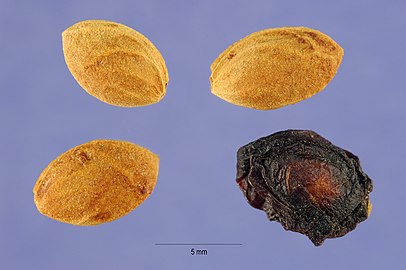|
Prunus emarginata
Prunus emarginata, the bitter cherry[2] or Oregon cherry, is a species of Prunus native to western North America, from British Columbia south to Baja California, and east as far as western Wyoming and New Mexico.[3][4] It is often found in recently disturbed areas or open woods on nutrient-rich soil.[5][6][7] DescriptionPrunus emarginata is a deciduous shrub or small tree growing to 1–15 metres (3+1⁄2–49 feet) tall with a slender oval trunk with smooth gray to reddish-brown bark with horizontal lenticels. As a tree west of the Cascade Crest the species commonly reaches 80 to a maximum of over 100 feet tall. The leaves are 2–8 centimetres (3⁄4–3+1⁄8 inches) long, thin, egg-shaped, and yellowish-green with unevenly sized teeth on either side. The flowers are small, 10–15 millimetres (3⁄8–5⁄8 in) diameter, with five white petals and numerous hairlike stamens; they are almond-scented, and produced in clusters in spring, and are pollinated by insects. The fruit is a juicy red or purple cherry 7–14 mm (1⁄4–1⁄2 in) diameter, which, as the plant's English name suggests, are bitter. As well as reproducing by seed, it also sends out underground stems which then sprout above the surface to create a thicket.[6][7][8] There are two varieties:[6][2]
Similar speciesPrunus pensylvanica, the pin cherry, is closely related.[9] EcologyMammals, deer and livestock forage on the leaves.[10] The cherries are eaten by some birds (especially cedar waxwing),[11] who in turn distribute the seeds.[9] The seeds have hard shells which can preserve them for decades before being released by fire.[9] The tree is a larval host to the blinded sphinx, elegant sphinx, Lorquin's admiral, pale tiger swallowtail, small-eyed sphinx, spring azure, twin-spotted sphinx, and western tiger swallowtail.[12] CultivationIt has hybridized with the introduced European Prunus avium in the Puget Sound area; the hybrid has been named Prunus × pugetensis. It is intermediate between the parent species, but is nearly sterile, producing almost no cherries.[13] UsesThe extremely bitter cherries are inedible to humans.[11] Native Americans used the bark in basket making.[9] MedicinalNative tribes, most notably Kwakwaka'wakw, used parts of the plant for medicinal purposes, such as poultices and bark infusions.[14] The isoflavone prunetin was isolated for the first time by Finnemore in 1910 from the bark of P. emarginata.[15] References
External linksWikimedia Commons has media related to Prunus emarginata. |
||||||||||||||||||||||||||||||||||||||||||||
Portal di Ensiklopedia Dunia





